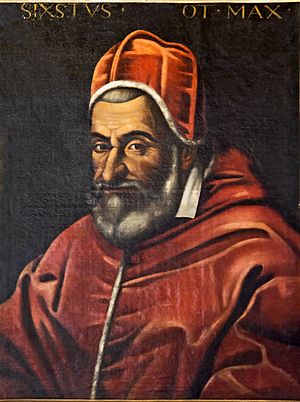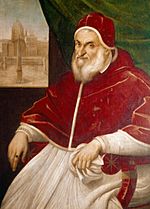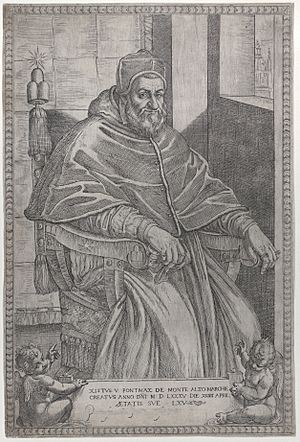Pope Sixtus V facts for kids
Quick facts for kids Pope Sixtus V |
|
|---|---|
| Bishop of Rome | |

Sixtus V in a 17th-century painting at the Albi Cathedral
|
|
| Church | Catholic Church |
| Papacy began | 24 April 1585 |
| Papacy ended | 27 August 1590 |
| Predecessor | Gregory XIII |
| Successor | Urban VII |
| Orders | |
| Ordination | 1547 |
| Consecration | 12 January 1567 by Antonio Lauro |
| Created Cardinal | 17 May 1570 |
| Personal details | |
| Birth name | Felice Piergentile, then Felice Peretti |
| Born | 13 December 1521 Grottammare, Papal States |
| Died | 27 August 1590 (aged 68) Rome, Papal States |
| Previous post |
|
| Motto | Aqua et panis, vita canis (Water and bread are a dog’s life) |
| Coat of arms |  |
| Other Popes named Sixtus | |
Pope Sixtus V (born Felice Piergentile) was the leader of the Catholic Church and the ruler of the Papal States from April 24, 1585, until his death in August 1590. He was born on December 13, 1521, and passed away on August 27, 1590.
When he was young, Felice joined the Franciscan religious order. He was very good at studying and preaching. He became a favorite of Pope Pius V, who later made him a cardinal. As a cardinal, he was known as Cardinal Montalto.
As Pope, Sixtus V worked hard to make Rome safer and fairer. He also started a huge building program that changed the city. These big projects cost a lot of money, which came from taxes. His plans for other countries were very ambitious. He removed both Queen Elizabeth I of England and King Henry IV of France from the Church. He is seen as an important figure in the Counter-Reformation, a time when the Catholic Church made many changes. He is the last pope to use the name "Sixtus."
Contents
Who Was Pope Sixtus V?
Early Life and Becoming a Friar
Felice Piergentile was born on December 13, 1521, in Grottammare, a town in the Papal States. His father, Francesco Piergentile, was a gardener who had moved to Grottammare to escape problems in his hometown. Felice later changed his family name to Peretti in 1551. As a cardinal, he was called "Cardinal Montalto" to show his love for his home region.
Joining the Franciscans
When Felice was nine years old, he went back to Montalto to live with his uncle at the Franciscan Convent of San Francesco delle Fratte. At age 12, he officially joined the Franciscan Order as a novice, taking the name Fra Felice (Friar Felix) in 1535. From then on, he studied philosophy and theology in different convents. He finished his studies in Bologna in September 1544. He had already become a deacon three years earlier.
Rising Through the Church
Around 1552, important Church leaders like Cardinal Rodolfo Pio da Carpi and Cardinal Ghislieri (who later became Pope Pius V) noticed Felice. From that time, his career in the Church grew quickly. He was sent to Venice to be a chief inquisitor for the Venetian Holy Inquisition. However, he was so strict that he got into arguments, and the Venetian government asked for him to be recalled in 1560.
After a short time as a leader in his order, he went to Spain in 1565. He was part of a group sent by the Pope to investigate a charge of heresy against the Archbishop of Toledo. He didn't get along with Cardinal Ugo Boncampagni (who later became Pope Gregory XIII) during this trip, which affected some of his later decisions. When Pope Pius V became Pope, Felice quickly returned to Rome. Pius V made him an apostolic vicar (a special Church representative) for his order, and then a cardinal in 1570.
Life as a Cardinal
During the time of Pope Gregory XIII (1572–1585), who was a political rival, Cardinal Montalto lived a quiet life. He spent his time taking care of his property, the Villa Montalto. This villa was built by Domenico Fontana near the cardinal's favorite church in Rome. The first part of the villa was built between 1576 and 1580. After he became Pope, he expanded it and cleared space to create four new streets in 1585–86. The villa had two main buildings: the Palazzo Sistino and the Palazzetto Montalto e Felice.
Clearing these areas helped reduce crowding in the old parts of Rome. However, many Romans who lost their homes were very angry. This anger lasted for centuries until the decision was made to build the central train station in 1863. The station was built in the area of the Villa Montalto, which was then torn down.
Cardinal Montalto also spent this time studying. One of his projects was editing the writings of Ambrose, an important early Church leader. As Pope, he would personally oversee the printing of an improved version of Jerome's Vulgate, a Latin translation of the Bible.
Pope Sixtus V's Time as Pope
Becoming Pope

Even though he followed what was happening in the world, Felice was careful not to cause any trouble. This careful approach helped him get elected as Pope on April 24, 1585. He chose the name Sixtus V to honor Pope Sixtus IV, who was also a Franciscan. One reason some cardinals supported him was his strong health, which suggested he would be Pope for a long time. His papal coronation (the ceremony where he officially became Pope) was held on May 1, 1585.
Making Rome Safer and Stronger
The Papal States were in a very bad condition when Pope Gregory XIII died. Sixtus V took strong and quick actions to fix the problems. He was very strict about law and order. He worked hard to stop crime, making the country much safer. He also made sure people followed religious rules.
Next, Sixtus worked on improving the finances of the Papal States. He sold some offices (jobs), created new ways to collect money, and added new taxes. He gathered a large amount of extra money, which he saved for specific emergencies, like a crusade or defending the Holy See. Sixtus was proud of his savings, but the way he collected the money wasn't always good for the economy. Some taxes were very tough on people, and taking so much money out of circulation caused problems.
Big Building Projects in Rome
Pope Sixtus V spent huge amounts of money on public works. He carried out a big plan that he had thought about during his retirement. He brought water to the hills of Rome with the Acqua Felice aqueduct, which fed 27 new fountains. He also created new main roads in Rome that connected the great basilicas. He even asked his architect, Domenico Fontana, to redesign the Colosseum to be a silk-spinning factory with homes for workers.
Pope Sixtus V was inspired by the idea of a perfect Renaissance city. His big plan for Rome changed the old city to have "long straight streets, wide open spaces, similar buildings, many monuments, and clear views." The Pope had no limits to his plans and achieved a lot in his short time as Pope, always working very fast. He finished the dome of St. Peter's, built the loggia of Sixtus in the Basilica di San Giovanni in Laterano, and added the chapel of the Praesepe in Santa Maria Maggiore. He also added or repaired palaces like the Quirinal, Lateran, and Vatican palaces. He put up four obelisks, including the one in St. Peter's Square. He opened six new streets and restored the aqueduct of Septimius Severus (the "Acqua Felice"). He also made the Leonine City a new part of Rome.
Besides many roads and bridges, he tried to improve the air quality by paying to drain the Pontine Marshes. This project made good progress, with over 9,500 acres (38 km²) of land reclaimed for farming and manufacturing. However, the project was stopped after his death.
Sixtus used materials from old buildings to help construct new ones. For example, Trajan's Column and the Column of Marcus Aurelius were used as bases for statues of Saint Peter and Saint Paul. The statue of Minerva on the Capitoline Hill was changed to represent Christian Rome. The Septizodium of Septimius Severus, an ancient monument, was torn down for its building materials.
Changes in the Church
The way the Catholic Church was organized after Sixtus V owed a lot to him. He limited the College of Cardinals to 70 members. He also doubled the number of Church departments (called congregations) and gave them more responsibilities in 1588. He didn't fully trust the Jesuits, a religious group, and wanted to change their rules, but he died before he could do so.
In 1588, he created 15 congregations with his official document called Immensa Aeterni Dei.
Bible Editions
In May 1587, the Sixtine Septuagint, a Greek translation of the Old Testament, was published under Pope Sixtus V.
In May 1590, the Sixtine Vulgate, a Latin translation of the Bible, was released. This edition was introduced with an official letter from the Pope, which said the new Bible was the true and official version recommended by the Council of Trent. It stated that all future copies should be corrected using this edition and that "not even the smallest part should be changed, added, or removed."
Some historians say this edition had problems and was later withdrawn.
New Cardinals
During his time as Pope, Sixtus V created 33 new cardinals in eight different ceremonies. These included his grandnephew Alessandro Peretti di Montalto and Ippolito Aldobrandini, who would later become Pope Clement VIII.
He also officially recognized Saint Ubaldesca Taccini as blessed (beatified) in 1587 and made Didacus of Alcalá a saint (canonized) on July 10, 1588.
Pope Sixtus V and Other Countries
In his dealings with other countries, Sixtus V had very big plans. He dreamed of defeating the Turks, conquering Egypt, moving the Holy Sepulchre (Jesus's tomb) to Italy, and having his nephew become king of France. He was in a difficult situation because he couldn't support leaders he saw as heretics (those who went against Church teachings), but he also didn't trust King Philip II of Spain and worried about Spain becoming too powerful.
Sixtus agreed to again remove Queen Elizabeth I of England from the Church and to give a lot of money to King Philip II's Armada (a large fleet of ships). However, knowing how slow Spain could be, he wouldn't give the money until the invasion actually landed in England. This way, he saved a lot of money that would have been lost if the invasion failed. Sixtus had Cardinal William Allen write a message to be published in England if the invasion succeeded. This message strongly criticized Elizabeth I.
Sixtus also removed King Henry III of Navarre from the Church. Henry was expected to become the next king of France. Sixtus supported the Catholic League, a group fighting against Henry. However, he was annoyed by his forced alliance with King Philip II of Spain and looked for a way out. Henry's victories and the chance that he might convert to Catholicism gave Sixtus V hope. This made Philip II try to control his wavering ally even more. The Pope's talks with Henry's representative led to strong protests from Spain. Sixtus avoided making a final decision and waited until his death on August 27, 1590.
Death and What He Left Behind
Sixtus V died on August 27, 1590, from malaria. He became sick with a fever on August 24, and it got worse the next day.
When Sixtus V was dying, some people didn't like his strict rules. However, history now sees him as one of the most important popes. On the negative side, he could be quick to act, stubborn, harsh, and bossy. On the positive side, he had big ideas and put all his energy and determination into his projects, which often led to success. His time as Pope saw great plans and great achievements.
The changes Sixtus made to the streets of Rome were shown in a film called Rome: Impact of an Idea.
About 5,000 bandits were executed by Sixtus V in the five years before his death in 1590. However, there were still reportedly 27,000 more criminals free throughout Central Italy.
He was the last pope to use the name Sixtus.
Images for kids
See also
 In Spanish: Sixto V para niños
In Spanish: Sixto V para niños



